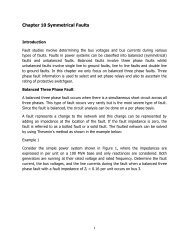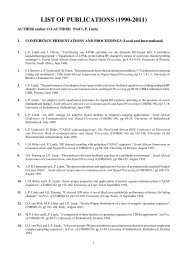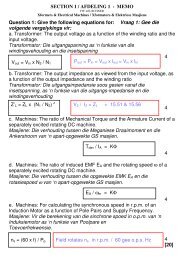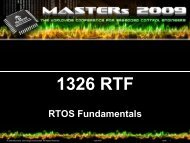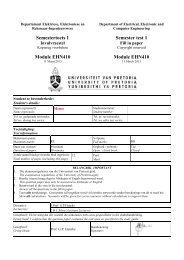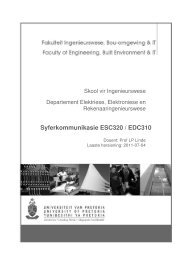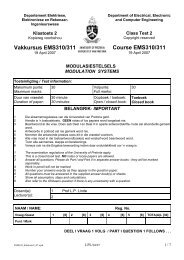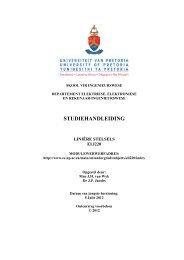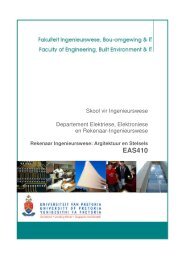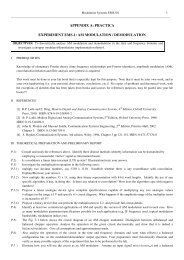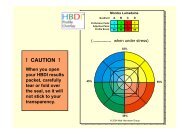Prakties 2 - Electrical, Electronic and Computer Engineering
Prakties 2 - Electrical, Electronic and Computer Engineering
Prakties 2 - Electrical, Electronic and Computer Engineering
You also want an ePaper? Increase the reach of your titles
YUMPU automatically turns print PDFs into web optimized ePapers that Google loves.
Figure 1. Reaction curve (m.s.t = maximum slope tangent. Reproduced from Goodwin et al., (2001))<br />
The values for , <strong>and</strong> are read off from the reaction curve where is the time at which the step was<br />
applied, is the time at which the system starts to react <strong>and</strong> is the time where the maximum slope<br />
tangent (drawn from ) intercepts the steady state output value. Once , <strong>and</strong> have been<br />
determined from the graph, the dead time, approximate time constant <strong>and</strong> gain are calculated. The dead<br />
time of the system is calculated as . The approximate time constant is <strong>and</strong> the<br />
gain is calculated as:<br />
where is the output <strong>and</strong> is the input. These values are then substituted into the equations from the<br />
following table to determine the PID parameters.<br />
[<br />
]<br />
( )<br />
Table 1: Controller settings for the Cohen-Coon process reaction curve method<br />
The st<strong>and</strong>ard form for the PID controller is given by:<br />
( ) (<br />
Note that the values in Table 1 (<strong>and</strong> Table 2) are given for the st<strong>and</strong>ard PID controller form.<br />
2.2 Ziegler-Nichols oscillation method<br />
This method is described in Seborg et al., (2004) as follows:<br />
1. After the process has reached steady state, eliminate the integral <strong>and</strong> derivative action (i.e.<br />
implement proportional only control).<br />
2. Set the controller gain to a small non-zero value.<br />
3. Introduce a small momentary set-point change <strong>and</strong> observe the output. Gradually increase the<br />
controller gain <strong>and</strong> repeat the introduction of the momentary set-point change until sustained<br />
oscillation is seen at the output. The oscillation at the output should have a constant amplitude (i.e.<br />
it should not die out over time). The numerical value of the proportional controller gain that<br />
produces the continuous oscillation is called the ultimate gain . The period of the oscillation is<br />
called the ultimate period .<br />
4. Calculate the PID controller settings from the Ziegler-Nichols tuning settings table.<br />
Ziegler-Nichols Method<br />
PID<br />
Table 2: Controller settings based on the Ziegler-Nichols oscillation method<br />
Control Systems (EBB 320) Practical 2 Guide 2012 Page 2<br />
)



